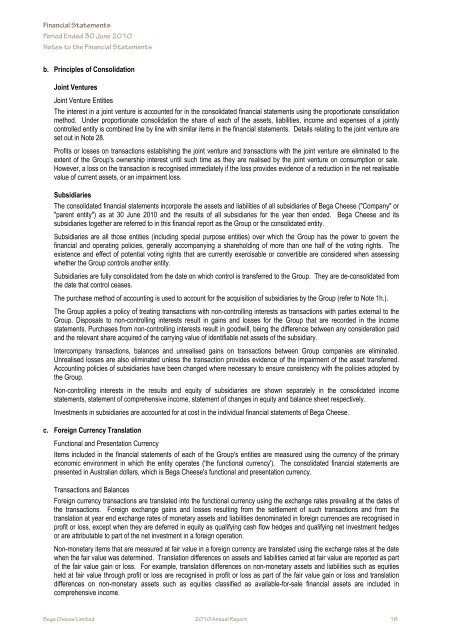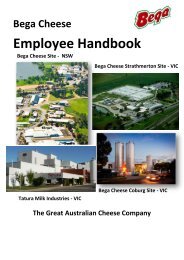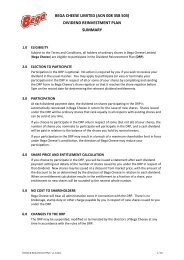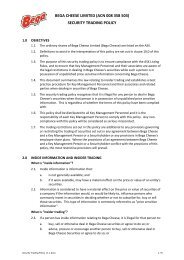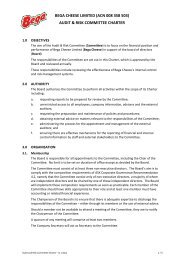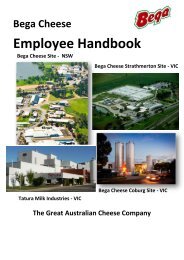Annual Report - Bega Cheese
Annual Report - Bega Cheese
Annual Report - Bega Cheese
You also want an ePaper? Increase the reach of your titles
YUMPU automatically turns print PDFs into web optimized ePapers that Google loves.
Financial Statements<br />
Period Financial Ended Statements 30 June 2010<br />
Notes Period to Ended the Financial 30 June Statements<br />
2010<br />
Notes to the Financial Statements<br />
b. Principles of Consolidation<br />
Joint Ventures<br />
Joint Venture Entities<br />
The interest in a joint venture is accounted for in the consolidated financial statements using the proportionate consolidation<br />
method. Under proportionate consolidation the share of each of the assets, liabilities, income and expenses of a jointly<br />
controlled entity is combined line by line with similar items in the financial statements. Details relating to the joint venture are<br />
set out in Note 28.<br />
Profits or losses on transactions establishing the joint venture and transactions with the joint venture are eliminated to the<br />
extent of the Group's ownership interest until such time as they are realised by the joint venture on consumption or sale.<br />
However, a loss on the transaction is recognised immediately if the loss provides evidence of a reduction in the net realisable<br />
value of current assets, or an impairment loss.<br />
Subsidiaries<br />
The consolidated financial statements incorporate the assets and liabilities of all subsidiaries of <strong>Bega</strong> <strong>Cheese</strong> ("Company" or<br />
"parent entity") as at 30 June 2010 and the results of all subsidiaries for the year then ended. <strong>Bega</strong> <strong>Cheese</strong> and its<br />
subsidiaries together are referred to in this financial report as the Group or the consolidated entity.<br />
Subsidiaries are all those entities (including special purpose entities) over which the Group has the power to govern the<br />
financial and operating policies, generally accompanying a shareholding of more than one half of the voting rights. The<br />
existence and effect of potential voting rights that are currently exercisable or convertible are considered when assessing<br />
whether the Group controls another entity.<br />
Subsidiaries are fully consolidated from the date on which control is transferred to the Group. They are de-consolidated from<br />
the date that control ceases.<br />
The purchase method of accounting is used to account for the acquisition of subsidiaries by the Group (refer to Note 1h.).<br />
The Group applies a policy of treating transactions with non-controlling interests as transactions with parties external to the<br />
Group. Disposals to non-controlling interests result in gains and losses for the Group that are recorded in the income<br />
statements. Purchases from non-controlling interests result in goodwill, being the difference between any consideration paid<br />
and the relevant share acquired of the carrying value of identifiable net assets of the subsidiary.<br />
Intercompany transactions, balances and unrealised gains on transactions between Group companies are eliminated.<br />
Unrealised losses are also eliminated unless the transaction provides evidence of the impairment of the asset transferred.<br />
Accounting policies of subsidiaries have been changed where necessary to ensure consistency with the policies adopted by<br />
the Group.<br />
Non-controlling interests in the results and equity of subsidiaries are shown separately in the consolidated income<br />
statements, statement of comprehensive income, statement of changes in equity and balance sheet respectively.<br />
Investments in subsidiaries are accounted for at cost in the individual financial statements of <strong>Bega</strong> <strong>Cheese</strong>.<br />
c. Foreign Currency Translation<br />
Functional and Presentation Currency<br />
Items included in the financial statements of each of the Group's entities are measured using the currency of the primary<br />
economic environment in which the entity operates ('the functional currency'). The consolidated financial statements are<br />
presented in Australian dollars, which is <strong>Bega</strong> <strong>Cheese</strong>'s functional and presentation currency.<br />
Transactions and Balances<br />
Foreign currency transactions are translated into the functional currency using the exchange rates prevailing at the dates of<br />
the transactions. Foreign exchange gains and losses resulting from the settlement of such transactions and from the<br />
translation at year end exchange rates of monetary assets and liabilities denominated in foreign currencies are recognised in<br />
profit or loss, except when they are deferred in equity as qualifying cash flow hedges and qualifying net investment hedges<br />
or are attributable to part of the net investment in a foreign operation.<br />
Non-monetary items that are measured at fair value in a foreign currency are translated using the exchange rates at the date<br />
when the fair value was determined. Translation differences on assets and liabilities carried at fair value are reported as part<br />
of the fair value gain or loss. For example, translation differences on non-monetary assets and liabilities such as equities<br />
held at fair value through profit or loss are recognised in profit or loss as part of the fair value gain or loss and translation<br />
differences on non-monetary assets such as equities classified as available-for-sale financial assets are included in<br />
comprehensive income.<br />
<strong>Bega</strong> <strong>Cheese</strong> Limited 2010 <strong>Annual</strong> <strong>Report</strong> 18<br />
<strong>Bega</strong> <strong>Cheese</strong> Limited 2010 <strong>Annual</strong> <strong>Report</strong> 18


